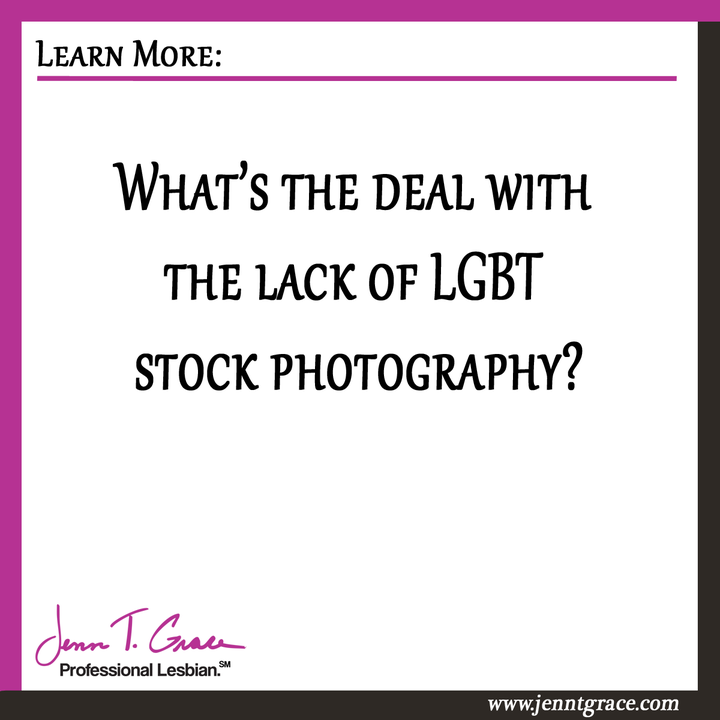
A Chief Diversity Officer (CDO) from a Fortune 500 that I have worked with in the past gave me a call and asked me, “Do you know of any good places to purchase LGBT stock photography?” I sighed and said, “Unfortunately, there just doesn’t seem to be a good spot.”
I have helped many business owners build websites, create LGBT marketing plans and put together simple print advertisements that are oftentimes in need of LGBT photography. It truly is slim pickings. I am not saying that no LGBT stock imagery exists, but the stuff that is out there is often riddled with problems.
Here are a couple of issues I have found with LGBT stock photography, and then I’ll share a few examples of how to solve this problem in your business.
The photo you are going to use is already being used by 1,000 other people trying to sell their products or services.
I see this time and time again. You’ll see a major company come out what appears to be a great new LGBT ad campaign, and within two seconds you can see that they purchased the same lesbian couple that four of their competitors and 25 companies outside of their industry are already using. This is happening with some very large brands.
The photos may or may not be genuine LGBT folks.
I had a really interesting conversation with a photographer who was telling me about a photo shoot he was a part of. He began telling me that getting some “LGBT shots” was on the list of items for the day. When one of the two male models was told this he became indignant about not wanting to do it but eventually conceded.
The problem with this is that those seemingly great LGBT shots are now on a stock photography website, and it is two straight guys being paid to be gay in some photos ― and one of them is a homophobe. Clearly, from the outside no one would be able to tell all that from a single picture, but to me its the principle behind it. A consumer could easily look at the photos and just think something doesn’t look right now being able to identify exactly what.
Stock photography relies on stereotypes a lot of times.
You are in somewhat of a “damned if you do, damned if you don’t” state. You could have a picture of two very feminine women and could have someone looking at your use of that photo and dismiss it because they can’t possibly be lesbians. This is irritating, but it’s a common occurrence. This goes the same for two men. If the person viewing the images you are using has a notion of what LGBT looks like in their head whether its based on stereotypes or not – you are in a lose-lose scenario.
So when I was talking with this CDO, I outlined these problems to him, and I was basically confirming to him what his gut was already saying. There are a few ways around this.
If you are with a large company that can afford an LGBT specific photo shoot – do it!
There is nothing more genuine and authentic than using your own LGBT employees for your company’s marketing. I’ve seen a handful of companies do this, and it is going to have a major return on investment. It solves all three problems outlined from above. No one else will be using these photos, because they are yours. No one can question the authenticity of the photos, because you can verify they are of your own employees. And the LGBT stereotype conversation can go out the window, because if you are using LGBT people from within your own company, whether they fall into a stereotype or not won’t matter as much because you can verify who they are because they are your employees.
Now, for those of you who do not have employees or are working on a shoe string budget where a photo shoot is just not feasible, there are a few things that you can do.
You can use yourself or someone you know who is LGBT.
It may sound a bit crazy, or you may not want to put yourself out there, but I’ll tell you what: it does the job inexpensively.
I did this when I was the marketing manager in the trenches of preparing the LGBT outreach for the company I was working for. (If you don’t know how I made the business case for this, check out this blog post.) The company I was working for had many people who were homophobic jerks, and I was the only person out of 90 or so who was LGBT. It was a rough environment for me for a lot of reasons, but when I was preparing this campaign I didn’t like the stock photography available, so I took a picture with my girlfriend at the time and we used that in our marketing materials. And it did the job, because no one else was using it. I tried doing a Google search for the image but couldn’t find anything, which at this point is probably a good thing.
You could ask your customers or those who are loyal to your brand if they would be willing to share a picture with you that you could use in your marketing materials.
Be specific on what type of image you are looking for and what the purpose and intention of this image will be. Clearly someone wouldn’t want to give you a fun family photo of themselves and come to find out you’ve cropped out the kids and are using their images to sell explosives or something extreme.
The best way to protect yourself in either of these scenarios is getting a photo agreement together that outlines the particular usages of the photo and that you have the ability to use it in pre-determined places. It doesn’t have to be big fancy contract or agreement but needs to provide basic protections to both the business owner and the person providing their images to be used.
I hope you have found value you in this post and go forward and kick some serious butt in whatever LGBT-related marketing endeavors you take on. If you feel I have overlooked something, please let me know. Also, if you have enjoyed this post I’d love for you to share with a friend! The more knowledge out there about options the better for the LGBT community as a whole.
